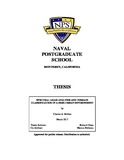Combining spectral and spatial information into hidden Markov models for unsupervised image classifciation
| dc.contributor.author | Tso, B. | |
| dc.contributor.author | Olsen, R.C. | |
| dc.date.accessioned | 2014-12-05T19:26:38Z | |
| dc.date.available | 2014-12-05T19:26:38Z | |
| dc.date.issued | 2005-05 | |
| dc.identifier.citation | International Journal of Remote Sensing, Volume 26, No. 10, May 2005, pp. 2113-2133 | |
| dc.identifier.uri | https://hdl.handle.net/10945/43860 | |
| dc.description.abstract | Unsupervised classification methodology applied to remote sensing image processing can provide benefits in automatically converting the raw image data into useful information so long as higher classification accuracy is achieved. The traditional k-means clustering scheme using spectral data alone does not perform well in general as far as accuracy is concerned. This is partly due to the failure to take the spatial inter-pixels dependencies (i.e. the context) into account, resulting in a â busyâ visual appearance to the output imagery. To address this, the hidden Markov models (HMM) are introduced in this study as a fundamental framework to incorporate both the spectral and contextual information in analysis. This helps generate more patch-like output imagery and produces higher classification accuracy in an unsupervised scheme. The newly developed unsupervised classification approach is based on observation-sequence and observation-density adjustments, which have been proposed for incorporating 2D spatial information into the linear HMM. For the observation-sequence adjustment methods, there are a total of five neighbourhood systems being proposed. Two neighbourhood systems were incorporated into the observationdensity methods for study. The classification accuracy is then evaluated by means of confusion matrices made by randomly chosen test samples. The classification obtained by k-means clustering and the HMM with commonly seen strip-like and Hilbert-Peano sequence fitting methods were also measured. Experimental results showed that the proposed approaches for combining both the spectral and spatial information into HMM unsupervised classification mechanism present improvements in both classification accuracy and visual qualities. | en_US |
| dc.rights | This publication is a work of the U.S. Government as defined in Title 17, United States Code, Section 101. Copyright protection is not available for this work in the United States. | en_US |
| dc.title | Combining spectral and spatial information into hidden Markov models for unsupervised image classifciation | en_US |
| dc.type | Article | en_US |
| dc.contributor.department | Physics | |
| dc.description.funder | The authors would like to convey their gratitude to the Remote Sensing Laboratory, Naval Postgraduate School, USA, for providing facilities in supporting this research project. | en_US |





